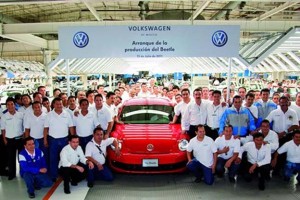While Mazda may have abandoned its decades-old joint venture with Ford, transferring production of the Mazda6 sedan back to Japan, the maker isn’t walking away from North American production entirely.
By mid-decade, the Japanese maker plans to open a new factory in Mexico to produce smaller products like the Mazda3. And it isn’t alone. Honda, Audi and Nissan are among the growing list of automotive manufacturers who have announced big plans for Mexican plants. Mercedes-Benz is also expected to add an assembly line South of the Border to complement the factory it currently operates in Alabama.
It’s all expected to add up to a whopping 38% jump in automotive production in Mexico over the next three years – an additional 1 million vehicles, according to the head of that nation’s investment promotions agency.
“Other companies are exploring the possibility of opening facilities in Mexico,” Carlos Guzman, president of ProMexico, told the Bloomberg News Service. “We expect a very good period of five to seven years in Mexico in terms of growing (automotive) exports.”
There are a number of reasons behind Mexico’s rapid growth as an automotive industrial base. There’s its proximity to both the U.S. and booming markets in Latin America. Sales in Brazil, for example, are expected to grow by a million over the next half decade, forecasts Fiat/Chrysler CEO Sergio Marchionne. And Mexico is one of that Portugese-speaking market’s major vehicle sources.
In fact, Mexico has more free trade agreements than any other nation in the world except Israel, industry sources point out, including the NAFTA deal with the U.S. and Canada. That simplifies exports and sharply reduces tariffs.
That also offsets lower wage rates in other emerging auto markets, such as China – where labor costs have actually been on a fast rise. Mexican workers earn an average of about $8 an hour in wages and benefits, compared to $50 in the U.S.
Geography also works in Mexico’s favor in that it is close to the American parts supply base. And it is positioned to give exporters ready access to both the Atlantic and Pacific Oceans.
“As an established carmaking location, Mexico offers an excellent economic basis for Audi production operations,” Audi Chairman Rupert Stadler said in April, when announcing the maker’s first North American plant. “Mexico is one of the world’s top ten automotive locations and offers a blend of tradition and experience.”
On the downside, Mexico remained embroiled in a violent drug war that has shaken many parts of the country. Things have remained under reasonable control in some regions, such as Aguascalientes, where Nissan currently operates a major plant and will soon add an even larger manufacturing complex. But in other Mexican states the situation has become bad enough that some automakers and suppliers have pulled out expat employees.
While the drug war is far from settled, a growing number of manufacturers appear to be willing to risk further investments – announcing $2.8 billion in spending last year and nearly doubling that, to $5.3 billion, during just the first four months of 2012, Mexico’s Economic Ministry reported.
The new Nissan and Audi facilities were a big chunk of that. But other big projects appear to be in the works.
Mercedes has so far only said it is looking for a second location in North America, but as TheDetroitBureau.com previously reported, senior company insiders say the focus is on Mexico – more precisely, on a location near the second Nissan facility in Aguascalientes. That’s no surprise as Nissan, Mercedes’ parent Daimler AG and Renault have been expanding a new alliance that could have them working closely together in Mexico on a variety of vehicles and components.
For a country struggling to shake off centuries of economic malaise – and to give its population alternatives to the unhealthy choice between poverty and drug dealing – automotive manufacturing is clearly appealing. According to ProMexico, combined auto and aerospace exports are expected to jump 15% this year, to around $400 billion.

